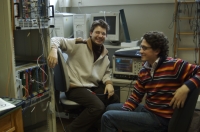 |
 |
|||||||||||||
|
|||||||||||||
|
|||||||||||||
|
Not many people see an immediate connection between exploring the origins of the Universe and finding cancer cells. Nicola d'Ascenzo and his colleagues sure do. In their work to test photo sensors as potential candidates for an ILC hadronic calorimeter they have come across a sensor that could be extremely interesting for positron emission tomography or PET, an imaging techniques that identifies cancerous cells in a body by detecting emitted gamma rays. Detect is the key word that links the two remote subjects: just like the hadronic calorimeter measures the energies of passing particles by collecting information from the photons that have been created when the particles crossed a scintillator, a positron emission scanner detects gamma rays emitting from the patient's body. Current PETs use photomultiplier tubes for this job, but the chips used for calorimeter prototypes - silicon photomultiplier (SiPM) and multi-pixel photon counter (MPPC) - might revolutionise the cancer detection technology. “The new chips are much smaller, have better resolution and are very fast,” says d'Ascenzo, an Italian working in the ILC detector team at DESY. “Hospitals could use detectors that already have the right shape, for example to spot breast cancer, rather than putting the whole person into a large and rather scary tube.” PET is often used to find cancers by highlighting areas of activity, but to locate the cancer cells more precisely it is often used in combination with magnetic resonance imaging (MRI). The magnetic field produced by the MRI, however, disturbs the photomultiplier tubes that are currently used in PET scanning. Silicon photomultipliers and multi-pixel photon counters don't feel the magnetic field, so PET and MRI could be combined into one apparatus in the future, making life easier for the patient. PET will always remain an expensive diagnostics machine because hospitals need a cyclotron to produce the beta-plus emitting substance that patients receive before a scan. The emitter reacts with glucose in the body and produces two gamma-ray photons, and as areas around active cancer cells are rich in glucose they show up well in the detectors. Nicola d'Ascenzo is part of the Helmholtz-funded young investigators group, run by Erika Garutti, that tests SiPMs for use in the hadronic calorimeter and participates in the construction of the calorimeter prototype of the CALICE project. They have devised an experimental set up that compares the hits a chip records with the hits a conventional photomultiplier tube records. A series of undergraduate and sometimes even high school students has helped in documenting the results. “I think it is extremely important to train the next generation,” says PhD student d'Ascenzo, barely in his mid-twenties himself. “School kids come here, learn something about physics, get hooked and then carry their knowledge and logic into the world. That's almost an even more exciting spin-off than the PET results,” he says. One of the students working in the laboratory is Alexander Tadday from Heidelberg University in Germany. His university wants to set up a test facility for the silicon-based photo sensors as well, so his diploma thesis is about their experimental setup at DESY. “We're still working on it,” he explains, “but it's looking really promising so far. We're especially interested in the timing - how fast the chips really are.” The group plan to publish a paper on their joint work on MPPC. It is, however, too soon to start talking to medical companies about the possible use of the SiPMs and MPPCs. More measurements are needed for a full characterisation of the chips. -- Barbara Warmbein |
|||||||||||||
| © International Linear Collider |
